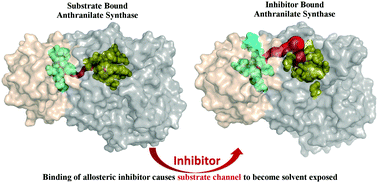Uncoupling of an ammonia channel as a mechanism of allosteric inhibition in anthranilate synthase of Serratia marcescens: dynamic and graph theoretical analysis†
Abstract
Anthranilate synthase (AS) is the first branch node enzyme that catalyzes the conversion of chorismate to anthranilate in the high energy-consuming tryptophan biosynthetic pathway in Serratia marcescens. AS, with an allosterically-bound inhibitor (tryptophan), shows complete inhibition in its catalytic function, but the inhibitor-bound structure is very similar to that of the substrate-bound AS. Even though the reaction mechanisms of several chorismate-utilizing enzymes are known, the unusual structure–function relationship in catalysis and allosteric inhibition of AS by tryptophan, with an insignificant change in structure, remains elusive. In the absence of structural variation, we use an integrated computational approach of coarse-grained protein contact networks, Gaussian network model, and atomistic Molecular Dynamics simulations of the substrate-bound and inhibitor-bound AS structures, and show the role of small but critical allosteric changes that induce complete inhibition of AS activity. We predict, through dynamic correlation studies, perturbation in crucial inter-subunit interactions between the two substrate-binding sites (“ammonia channel”) and the allosteric inhibitor-binding site, and identify, through shortest path analysis, the non-active site residues participating in the communication pathways. We argue that such a regulatory mechanism (change in function without a significant change in the structure) for catalysis is useful for a branch point enzyme that has to undergo fast redistribution of fluxes according to different metabolic states of the organism. Being essential to the survival of microorganisms, including pathogenic ones, and absent in mammals, AS is a highly attractive drug target. Thus, the allosteric AS residues participating in catalysis identified in this study could be important for drugability.



 Please wait while we load your content...
Please wait while we load your content...